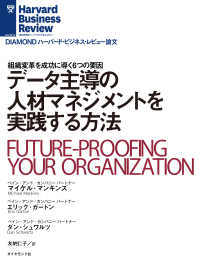- ホーム
- > 洋書
- > 英文書
- > Computer / General
Full Description
Cisco Unified Contact Center Enterprise (UCCE)The complete guide to managing UCCE environments: tips, tricks, best practices, and lessons learnedGary FordCisco Unified Contact Center Enterprise (UCCE) integrates multiple components and can serve a wide spectrum of business requirements. In this book, Gary Ford, an experienced Cisco UCCE consultant brings together all the guidance you need to optimally configure and manage UCCE in any environment.The author shares in-depth insights covering both the enterprise and hosted versions of UCCE. He presents an administrator's view of how to perform key UCCE tasks and why they work as they do. He thoroughly addresses application configuration, agents, scripting, IVR, dial plans, UCM, error handling, reporting, metrics, and many other key topics.You'll find proven, standardized configuration examples that help eliminate errors and reduce downtime, step-by-step walkthroughs of several actual configurations, and thorough coverage of monitoring and troubleshooting UCCE systems.Cisco Unified Contact Center Enterprise (UCCE) is an indispensable resource to help you deploy and operate UCCE systems reliably and efficiently.Gary Ford has spent more than 13 years designing, deploying, and maintaining Cisco telephony and contact center solutions together with several of the world's largest systems integration companies, Cisco ATPs, and customers. He was first introduced to contact centers in 1997 while working for British Telecom (BT) as a test engineer tasked with integrating the GeoTel ICR platform into BT's core telephony network. After Cisco acquired GeoTel, Ford's role evolved to include broader Cisco contact center and unified communications consulting. He holds a bachelor's of engineering degree in computer systems engineering, the status of Chartered Engineer, and several Cisco, Microsoft, and business-related professional qualifications.* Understand the Cisco Unified Contact Center product portfolio and platform architecture* Choose the right single-site, multi-site, or clustered deployment model for your environment* Take a lifecycle services approach to UCCE deployment and application configuration--including preparation, planning, design, and implementation* Implement traditional, current-generation, and next-generation call routing* Master the latest best practices for call flow scripting* Understand UCCE's nodes and distributed processes and build a clean system startup sequence* Design, implement, and deliver unified CM/IP IVR solutions* Set up and efficiently manage UCCE databases* Make the most of UCCE's reporting tools* Create advanced applications with Data-Driven Routing* Effectively maintain any UCCE deployment, including older versions* Use a best-practice methodology for troubleshooting, and master valuable, little-known Cisco diagnostic toolsThis IP communications book is part of the Cisco Press (R) Networking Technology Series. IP communications titles from Cisco Press help networking professionals understand voice and IP telephony technologies, plan and design converged networks, and implement network solutions for increased productivity.
Contents
Introduction xiChapter 1 Contact Center Overview 1Contact Center Characteristics 3Contact Channels 4Cisco Contact Center Features 5Virtual Contact Center 5Cisco Agent Desktop with Presence 5CTI and CRM Integration 6Agent Desktop Options 6Cisco Unified Expert Advisor 7Support for Remote and Mobile Agents 7Self-Service and Call-Treatment Capabilities 8Reporting 8Management Portal 9Cisco Contact Center Portfolio 9Cisco Unified Contact Center Express 11Cisco Unified Contact Center Enterprise 11Cisco Unified Contact Center Hosted 12Cisco Unified Intelligent Contact Manager Enterprise 13Cisco Unified IP IVR 13Cisco Unified Customer Voice Portal 14Other Voice Components 15Summary 16Chapter 2 Platform Architecture 17General Cisco Unified Contact Center Architecture 17Router 18Logger 18Administrative Workstation/Real-Time Distributor and Client AW 18Historical Data Server 19Peripheral Gateway 20CTI Server (Including CTI Object Server) 21Reporting (WebView and CUIC) 21Network Interface Controller 22Cisco UCCE 23Cisco UICM 23Cisco UCCH 24Platform Redundancy 25Summary 27Chapter 3 Deployment Models 29Single-Site 30Multisite with Centralized Call Processing 31Multisite with Distributed Call Processing 32Clustering over the WAN 33Factors to Consider When Choosing a Deployment Model 35Deployment Options 35Enterprise/System UCCE 35Parent/Child Deployment 36Real-World Deployments 37Summary 38Chapter 4 UC Operating Systems 39Operating Systems in Use 40MS Windows for Cisco Unified CM 40Cisco Voice Operating System (VOS) 40MS Windows for UICM/UCCE 41Bill of Materials (BOM) 41Third-Party Software 41Learning About Updates 42Summary 42Chapter 5 UCCE Road Map 43Cisco Software Product Lifecycle 43Software Phases 43Software Support Road Map 44Platform Upgrades 45The Evolution of UCCE 46GeoTel ICR 2.5 46GeoTel ICR 3.0/4.0/4.1 48ICM 4.5 48Cisco ICM 4.6 48Cisco ICM 5.0 49Cisco IPCC 7.0 50Cisco UCCE 7.5 50Cisco UCCE 8.0 51Cisco UCCE 8.5 51Summary 52Chapter 6 UCCE Platform Deployment 53Lifecycle Services Approach 54Prepare and Plan 57Design 57Software Versions 57Platform Sizing 59Platform Redundancy 60Server Naming Conventions 60Deployment Spreadsheet 61Network Services 63Databases 68Cisco A2Q Process 69Implementation 71Server Builds 71Software Installation 72Installation Order 74Implementation Testing 79Summary 82Chapter 7 UCCE Application Configuration 83Prepare 83Requirements Capture 83Capture Spreadsheets 84Implementation 84Configuration Manager 85Summary 96Chapter 8 Call Routing 97Call Routing Concepts 98Carrier-Based Routing 98Private Network Routing 101Traditional Call Routing 104Current-Generation Call Routing 105Prerouting 105Postrouting 107Next-Generation Call Routing 108SIP Trunks 108Summary 111Chapter 9 Call Flow Scripting 113Contact Center Call Flow 114Contact Center Challenges 114Call Script Development Lifecycle 115Call Scripting Best Practices 117Total Cost of Ownership 117Expect the Unexpected 118Change Is Good 118Tracking Change 119Script Layout 121Avoid Overoptimization 124Meaningful Names 126Comment Node 127Use a Development Workstation 128Custom Functions 129Error Handling 130Summary 131Chapter 10 Reporting 133Reporting Packages 134Cisco WebView 136Cisco Unified Intelligence Center 138VIM Performance 140Feature Comparison 142Wallboards 142UCCE Reporting 145Reporting Notes 146Reporting Terminology 146General Reporting with Call Types 147Call Queuing 149Hiding Objects 149Don't Mix and Match Reporting Entities 150Wrap-Up Codes 150Legacy Reports 151Summary 153Chapter 11 Nodes and Processes 155UCCE Nodes 157Logger 157Router 158Peripheral Gateway 160Administrative Workstation 162Common Processes 163Support Tools Node Agent 164UCCE Nodes Startup Sequence 164UCCE Detailed Startup 166Logger A 166Router A 170Peripheral Gateway A 172Logger B 179Peripheral Gateway B 181Administrative Workstation 182Summary 183Chapter 12 Unified CM and IVR 185Cisco Unified Communications Manager 185Cisco Unified IP Interactive Voice Response 186Cisco Unified Customer Voice Portal 186Integration with UCCE 187Unified Communications Manager 187UCCE with IP IVR 188UCCE with CVP 189Cisco Unified Communications Manager 189Cisco JTAPI 189CTI Route Points 190Agent Phone Settings 191Partitions and Calling Search Spaces 192Queuing and Self-Service 192CVP Versus IP IVR 196Cisco Unified IP IVR 197IP IVR Call Flow 197Cisco Unified CCX Editor 200IP IVR Configuration 201Cisco Unified CVP 203Summary 206Chapter 13 Data-Driven Routing 207What Can Be Achieved with Data-Driven Routing 208Data Lookup Options 210Static Lookup 211DB Lookup Node 211Application Gateway 212Within an IVR Application 212Agent Desktop/CRM Integration 213Configuring UCCE Database Lookup 213Step 1: Database Creation 213Step 2: Enable the DB Worker Process 214Step 3: Configuration Manager: Database Lookup Explorer 215Step 4: Simple Call Script and Testing 216Summary 217Chapter 14 UCCE Databases 219Relational Databases 219UCCE Databases 221Database Purge 222Database Schema Overview 224SQL Queries 227Finding a Call with a Specific ANI 228Finding Unassigned Call Types 229Listing the Most Popular Callers by ANI 229Locating the Last Script Node 230Locating Agents Against Agent Desk Settings 230Finding DNs Associated with a Call Type 230Agent State Trace 232Summary 233Chapter 15 Management and Administration 235Platform Management 236Potential Failures 236Backups 238Platform Monitoring 239Application Administration 245Summary 246Chapter 16 Troubleshooting 247Fault Logging and Handling 248Fault Logging 248Cisco Technical Assistance Center (TAC) 250Troubleshooting Methodology 251UCCE Process Tracing 254Setting Trace Levels 257Analysis Manager 258Support Tools 258Router Trace 260UCCE Command-Line Tools 262dumplog Utility 263opctest Utility 265rttest Utility 269procmon Utility 272UCCE Script Editor 273Monitoring 273Call Tracer 274Summary 275Index 277
-

- 電子書籍
- データ主導の人材マネジメントを実践する…
-

- 電子書籍
- めざすはシンデレラ【分冊】 8巻 ハー…
-

- 電子書籍
- 僕のヒーローアカデミア 25 ジャンプ…
-

- 電子書籍
- 関東・甲信越戦国の名城・古城歩いて巡る…




